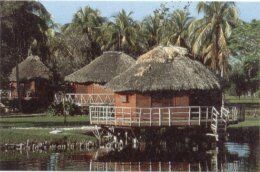(IN MATANZAS PROVINCE) | Places |
"MATANZAS" PROVINCE. INFORMATION
Matanzas province is aproximately 100 kilometers far from the cuban capital (Havana City). In the limits between Habana and Matanzas provinces people use to stop. There you can find the Bridge (Puente) of Bacunayagua of 150 meters high. It offers a beautiful sight of "Valle de Yumuri (Valley)", surrounded by mountains and bathed by Yumuri; and Bacunayagua rivers. In theYumuri Valley you can see the cuban nature in its all brightness.
This province is a faithful index of the afrocuban religion. The black slaves, settled in the vicinity of Yumury Valley, were prohibited to celebratetheir african cult. Then they identify their saints (called Orishas) with the christian saints because of the similarity between the colours of the clothes. That´s why the Caridad Virgin is Ochun (with yellow clothes), Santa Barbara is Shango (with red clothes), etc. From this place was born Palo Monte, Abacua; and santeria (religious practices), specially in the regions of Jovellanos, Colon and Matanzas city.
Matanzas Province has the following Municipalities :Matanzas, Varadero, Cardenas, Calimete, Jovellanos, Pedro Betancourt, Limonar, Union de Reyes, Jaguey, Colon, Cienaga de Zapata, Marti, Los Arabos and Perico.
Matanzas city, capital of the province is knowned as Athens of Cuba
ubicada a Matanzas city is located at the shore of bay with quite sea. At the beginning Matanzas was an aboriginal comunity known as Yucayo,
settled near the Guanimar Bay. Spanish people named the comunity as Matanzas,
after a ship with 30 men and 2 women shipwrecked close to the port and
were attacked and killed by the aborigins. In this area spanish people founded the city in
1693. It was named San Carlos y San Severino de
Matanzas.
Matanzas is the city of the bridges and the poets. In the heart of the city we can find the Jose White cultural center, where people danced the first "danzon" compounded by Miguel Failde more than a century ago. Matanzas became famous because of its excelent port, the intensive comercial activity and the development in the sugar cane industry.
The
Bellamar Cave (in Matanzas city), discovered
in XIX century, is one of the most visited cave in the cuban country. It´s more than
2 km long,and composed by crystalline formations with big quantity of stalagmites and stalactites, where the halls descend looking for the ground water and end in lakes with cristalline water.
Matanzas, nowadays very famous because of its 20 kilometers of beaches in Varadero. It´s 145 kilometers far from Havana and
located
on the Northern coast of Matanzas province, exactly in the narrow
Hicacos peninsula. The
fine white sand and its warm transparent waters makes from this place
one of the most important and recognized beaches in the world. All
this nature kindness are accompanied of touristy infrastructure,
always in development, where the most important attractives are : more than 20
areas to snorkeling, restaurants, night clubs, discos, golf fields with more than 18 holes and different hotels for all tastes. Moreover you can visit virgin islands and bottoms with coral and fishes variety, funny dolphins, lobsters, shrimps, crabs
and different types of molluscs.
Matanzas have facilities for yatchs concentrated in the touristy of Varadero. These are Puertosol Darsena, Marlin Chapelin and Gaviota navies, in wich more than 90 yatchs can moor. There you can do tours in yacht, siling boates and catamarans. Five specialized centres in scuba diving and snorkeling increase the province offer, three of them -Barracuda, Acua and Club Varadero-are located in the principal destination of Matanzas, with a big variety of activities that include the immersions in coral riffes and sank ships, submarine photos and water bicycle.
Just 2 hours from Havana, Varadero is easy to reach from any part of the world. You can arrive either by direct flight to its international airport or by private boat to its harbor, or by well maintained roads from any region of the Island. Yachts and private aircrafts can enter Varadero after you establish radio contact with Cuban authorities to receive the authorization.
In Peninsula de Zapata we can find the Touristy Centre "La Boca"
with one of the biggest breeding of cocodriles in the american continent.. There, in Laguna del Tesoro the visitors can find Guamá,
a picturesque touristy centre with 47 rooms. One of the attractions are the sculptures
 made by the cuban artist
Rita Longa, that represent the reconstruction
of a small village (aldea) from the aborigens (tainos). In the south part of Zapata peninsula, is located
the Natural Park Montemar, a paradise for people who love nature. This
incredible natural reserve has an area of hundreds square kilometers
of forest and coast vegetation, extensive places of moisture and manglars
which are the habitat of 160 species of birds and 900 of trees.
Mammals, fishes, and amphibians are joined to this wonderful show in
the Caribbean island.
made by the cuban artist
Rita Longa, that represent the reconstruction
of a small village (aldea) from the aborigens (tainos). In the south part of Zapata peninsula, is located
the Natural Park Montemar, a paradise for people who love nature. This
incredible natural reserve has an area of hundreds square kilometers
of forest and coast vegetation, extensive places of moisture and manglars
which are the habitat of 160 species of birds and 900 of trees.
Mammals, fishes, and amphibians are joined to this wonderful show in
the Caribbean island.
Related to the cuban history of the last 40 years you can visit Museo de Playa Giron (Museum). This place shows details of the army invasion in Playa Giron, that took place on 16th april 1961 and was defeated in only 72 hours by the revolutionary forces.